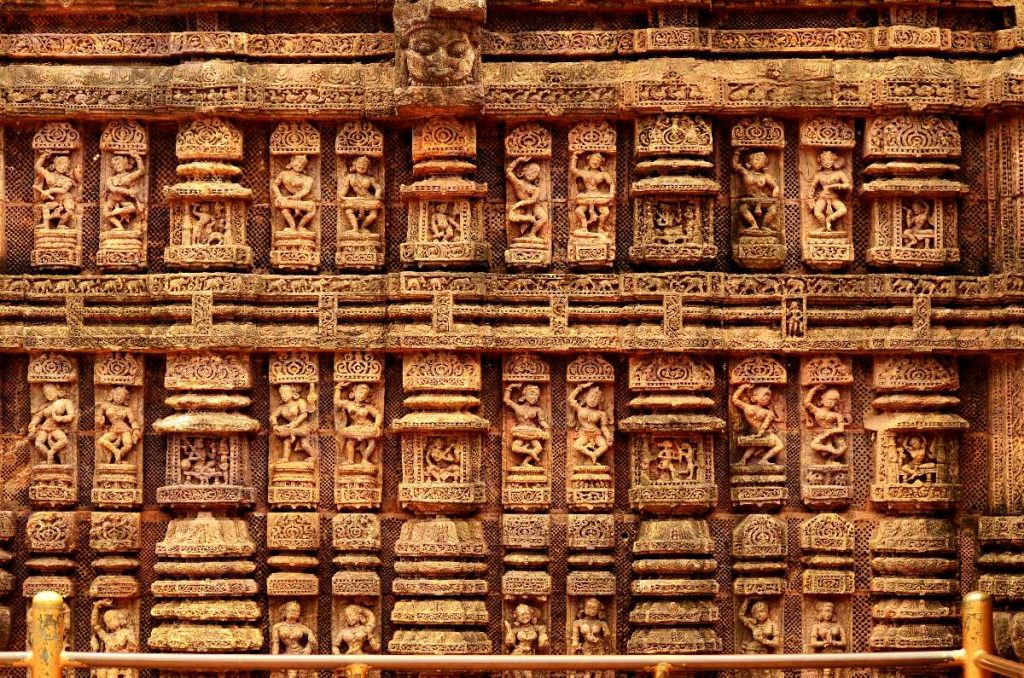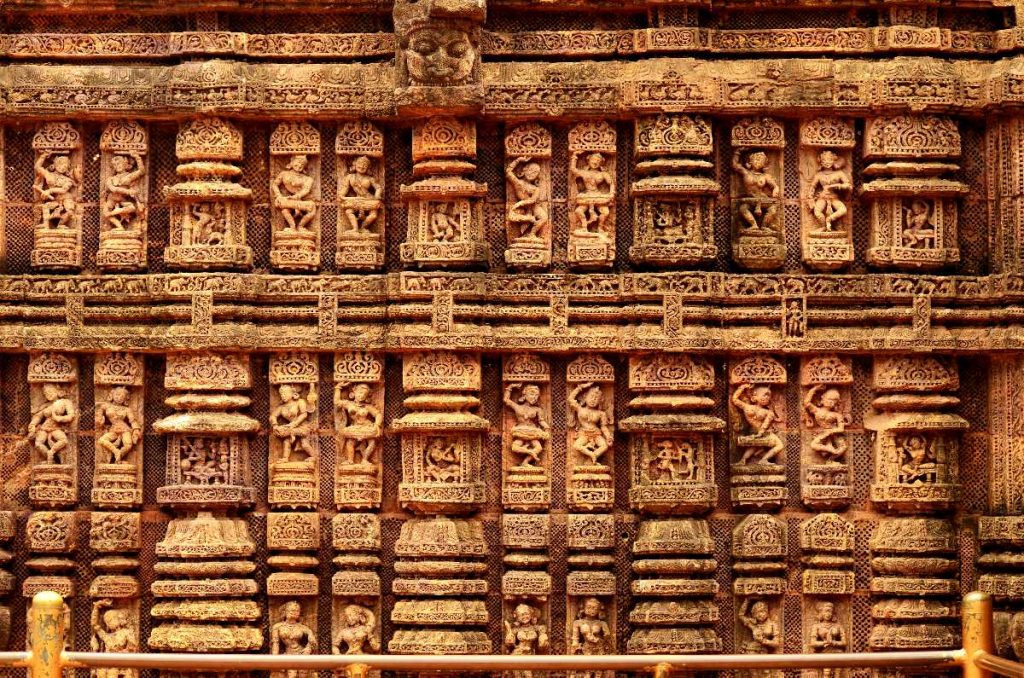The state of Odisha consists of a number of marvellous architectures. The ancient buildings and constructions of the historical age carry a lot of significance even today. One of such extraordinary works is the Sun Temple at Konark. The Chariot of The Sun God, The Konark Sun Temple is a magnificent temple dedicated to the living God Sun was built in the 13th-century CE.
Also known as Konark Surya Mandira, the Sun temple of Konark is situated about 35 kilometres northeast from Shree Khetra town Puri. King Narasimhadeva I The Sun Temple of Konark , also known as Langula Narasimha Deva of the Eastern Ganga Dynasty built the temple around 1250 CE. The marvellous architecture of the ancient Kalinga style makes it more ravishing.

Now, the remainder of the temple is what can be seen at Konark. A 100 feet high chariot with immense wheels and horses, all carved from stone is the remains of the temple. The original beauty of the temple as described in the history was full of charm. It was originally over 200 feet (61 m) high, with the top of the temple being wonderfully structured. As the temple appeared black, The Sun Temple of Konark , it was earlier called as Black Pagoda. Even today, people call it Black Pagoda. The temple of Konark is dedicated to the Hindu Sun God Surya.
The alluring Sun Temple stands facing the east–west direction. The inner sanctum or vimana used to be surmounted by a tower or shikara but it was razed in the 19th century. The audience hall or jagamohana still stands and comprises the majority of the ruins. The roof of the dance hall or The Sun Temple of Konark ,natmandir has fallen off. It stands at the eastern end of the ruins on a raised platform.

Even only the remains of the The Sun Temple of Konark , Temple are present now, but they highly showcase the Odisha style of Architecture or Kalinga architecture. The intricacies of artwork, iconography and themes that have survived display marvellous art skills of ancient workers. Erotic Kama and Mithuna The Sun Temple of Konark , Scenes are also structured on the walls of the temple. The Sun Temple of Konark , The temple is also adjacent to the sea shore of the Bay of Bengal which becomes a cause of attraction for the tourists. The history and heritage of the temple sings the glory of the state proudly.
Legends Behind The Temple
There are so many legends behind the building of The Sun Temple.
One of the legends say that one of Krishna’s sons, named Samba built the impressive Konark Sun Temple. The reason was to honor the solar deity for healing him. Although this temple was actually built during the 13th century, The Sun Temple of Konark , it was conceived to be a monumental representation of the chariot of Surya, the Sun God.
But according to historical sources, the Konark Sun Temple was built by Narasimhadeva I. He was a ruler of the East Ganga dynasty, during the 13th century AD.
It is said that the king decided to build this temple in order to commemorate his military victories against Muslim invaders. As Narasimhadeva was a devotee of Surya, he decided to have the temple built in the form of the god’s chariot.
There is also a great story relating to the temple which says that Bishu Moharana was the chief architect of the temple. Although a great artist he was and famous for his stone works, he and his mates could not complete Shikhara or the topping of the temple in the required time.
The King ordered the workers to complete building the temple in time or else to give their lives. Dharmapada, the son of Bishu Moharana, reached at that point and finished the temple. To save the King’s question about how the temple was finished and the lives of the workers and his father, Dharmapada jumped into the Chandrabhaga river nearby.
A folklore states that a diamond was present in the centre of the idol reflected the sun rays that passed through it. In 1627, the then Raja of Khurda took the Sun idol from Konark to the Jagannath temple in Puri. The Sun temple belongs to the Kalingan school of Indian temple architecture.
You can read our another post on Forest Fire in Odisha: A Devastating Threat to Biodiversity and Ecosystems
The Architecture And Building Style
The style of Konark Temple is a combined form of both Kalinga Architecture and Nagara style temple building. Konark is the word which literally means ‘Angle’ Or Kona and ‘Sun’ or Arka. The temple was built in an angular form while the main deity of the temple is The Sun. The Konark temple stands unique in its style and architecture. The temple has a good name in the World as well.
The material of the Konark temple is stone. It is in the form of a colossal chariot with twelve pairs of lavishly-ornamented wheels, drawn by seven richly-caparisoned, galloping horses. The Sun Temple of Konark , The wheels have been carved against the sides of the “chariot”. .

The conception of this temple in the form of a chariot has mainly to do with Hindu beliefs regarding Surya that he is usually found on a chariot pulled by seven horses. Thus, the depiction of a chariot invariably became part of any artistic creation related to the sun god in India. The 12 pairs of wheels represent the 12 months of the year.
Once The Sun Temple was a major pilgrimage site of Odisha. Having a large complex and the intricate features of the premises of the temple fetched a number of tourists. Famous Chinese Monk Huen Tsang also travelled to Konark during 8th Century CE. At that time, The Sun Temple of Konark , was a centre of Buddhism.
Causes of Destruction of The Temple
There are only legends behind the destruction of the temple. But no definite cause is there that reveals the real cause. Some say the temple got damaged due to natural causes and some explain the Muslim invasion of the temple causing massive destruction. The temple is believed to be destroyed between the 15th and 17th centuries.
Legend has it that the temple was held together with a huge magnet. Ships were forbidden to get close to The Sun Temple of Konark ,shore, lest the iron nails holding the planks together got pulled out by the magnet. It is said that Muslim invaders removed the magnet from the temple, causing the structure to fall into itself.
How to Reach
By road: There are tour buses and taxis available at capital city Bhubaneshwar that take you to Konark on a 60km ride.
By rail: The nearest railway station is Puri, about 35km from Konark. You can hire taxi services for the rest of the way.
By air: The nearest airport is at Bhubaneshwar.
Conclusion
The temple that exists today was partially restored by the conservation efforts of British India-era archaeological teams. The Sun temple was declared a UNESCO world heritage site in 1984. Pilgrims and tourists visit in a large number to this place round the year. Mostly, in the month of February, people gather here during the Chandrabhaga Mela, a fair arranged for the public.

